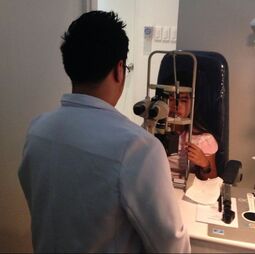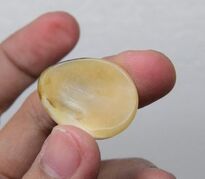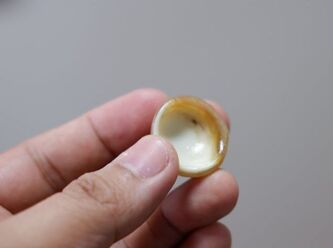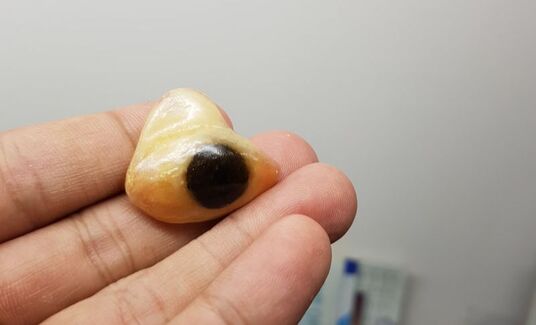|
Most patients who wear prosthetic eye experience some discomfort after a while. That is why it is very important to be aware of the different conditions or circumstances that may cause these discomforts. It is also important to know how to address them properly at the right time and with the right procedure. To make sure that it would be a little bit easier for patients and their families to remember the list of discomforts and the necessary steps to be taken to correct them, we will try to enumerate them by giving them one-by-one through the letters: D-I-S-C-O-M-F-O-R-T: D – Dry Mucous Incomplete closure of the eyelids(Right Eye) Incomplete closure of the eyelids(Right Eye) Some instances dry mucous build-up roughly on the socket with a prosthetic eye. This happens if the patient's eyelids do not close completely over the prosthesis during sleep. It results in the accumulation of partially dried matter on the front of the eye as they wake up in the morning. A rolled-up tip of a quality facial tissue moistened with warm water can help in clearing this off. It doesn't need to remove the eye. Just make sure that you'll never use any kind of cloth because it can dull the surfaces of the eye. It’s observable that patients whose eyelids that close completely during sleep can have a very slow building up of matter. It usually starts as a thin film that is difficult to see. But this can also make the surface of the eye a little bit rough and can irritate the underside of the eyelids as they blink. One can already suspect the possible presence of this thin film if the eye socket is irritated with scratching and itching or burning sensation. In this situation, it is very important to remove the prosthesis and carefully, but thoroughly, cleaned. I – Infection A patient must always remember that the socket tissues around the prosthetic eye can also become infected the same way that the companion eye can be. Different bacterial and viral infections may happen. Discomfort and yellow/greenish discharge can be some of the indications of infections. The tear duct or drainage may be closed. In these instances, it is very important to consult one's eye care specialist for proper medications and treatment. S – Surface Polish A Poorly polished Prosthetic Eye A Poorly polished Prosthetic Eye There are some instances that that surface polish of the prosthesis is lost and some deep scratches happen. These can be the results of dust in the air that can get in the tear film and the scrubbing of the eyelids while blinking may reduce the polish of the surface of the plastic. This has happened to many patients. Sometimes when prosthetics drop onto hard and rough surfaces, deep scratches are left on the eye. Both of these can irritate the underside of the eyelids. To correct this issue, the eye must be re-polished. It is recommended that prosthesis must be re-polished at least once a year. This is to maintain the comfort of the eye socket. This may reduce any potential discharge. C – Common ColdSome patients have observed that when they have a common cold, they feel some discomfort. Mattering and some discharges from the socket of the prosthesis also happen while the other companion eye seems to be unaffected. It is very essential that during this period, removing the eye and washing it once a day may reduce the discomfort and discharge. O – Old Plastic Eye A Prosthetic Eye with discoloration A Prosthetic Eye with discoloration Old plastic or prosthetic eye can accumulate toxic substances. This may develop after a long period. Some prosthesis is made of acrylic plastic or Methyl Methacrylate Resin that has intermolecular spaces that are large enough for the passage of water molecules and may take up water slowly while it is being bathed or washed. Water may move continually and stay in the empty spaces. With this, viruses and some bacteria can grow into the eye. Evidence shows that proteins gather in the plastic and that these may bring irritation in the eye socket. For some, polishing or even refitting won’t make them comfortable. The correction of this problem is simply to have a new prosthetic eye made of new plastic. M – Mishandled prosthesisA proper handling procedure is a must. It is very vital that prosthetic eyes are handled properly and taken cared of cautiously. If a patient or his or her caregivers do not have that conscious effort of taking care of the prosthetic eye and the patient's eye, most of the time irritations and discomforts happen. Bacteria and viruses, foreign matters and some other microorganisms that may cause problems may occur. F – Foreign BodiesThere will be some instances that foreign bodies will get into the eye socket of the prosthesis. Sometimes dust or other larger particles can enter into the eye socket. An eyelash can be carried into the socket while replacing the eye. When these happen, it can cause some discomfort and irritation. Thus, it requires removal and thorough cleaning. O – OpthalmitisOpthalmitis or sympathetic Opthalmitis can be caused by the surgery made on the damaged eye. It harms the healthy aye following eye removal. It shows as an inflammation of the healthy eye. Although it is treatable, it can also lead to vision loss in a healthy eye. This may be caused by infection and if not treated properly it may cause some discomforts and may lead to a bigger problem for the eye socket of the prosthesis. This can be easily treated using antibiotic drops or oral antibiotics. R – Reaction to AllergiesHouse dust, animal hair, pollens from plants, dairy products, potatoes, and other foods may cause some allergies to some individuals. And sometimes may affect the surface tissues of the eyes without being aware of any discomfort. In this situation, it is very important to know the person's allergies by consulting an allergist and an ophthalmologist to have proper awareness of this. Completely cured prosthetic eye which has been made-up of pure, medical-grade acrylic usually does not cause allergy. While there is no guarantee, perfectly fitted, fabricated and carefully cured prosthetic eye, is far from being a cause of allergies. T – TearsIt would be embarrassing for a person wearing a prosthetic eye would have some sudden discharges of large stale tears and mucous over the eyelid onto the face. Yes, sometimes it happens when the eye socket has accumulated tears and produced some mucoid discharges. This is caused by salts from the tears that irritate the tissues produce some mucus. Everyone must be aware that eye sockets of most persons change in shape slowly over time; due to the effects of the surgery, aging and fat wastes from the depths of its orbit. This results in pockets of space between the eye and the tissues, and if filled with tears and if collected it becomes stale or hard, thus, causing irritation and some discharges. With all of these discomforts, a patient and those who take care of them must have constant contact with their eye care specialist. Regular consultation and check-ups are necessary to make sure that the prosthetic eye and its companion eye remains healthy. References: Causes for Prosthetic Eye Discomfort. (n.d.). Retrieved July 23, 2019, from https://carolinaeyeprosthetics.com/causes-prosthetic-eye-discomfort/ Cirino, E. (2018, May 24). Prosthetic Eye: Cost, Care, Surgery, and More. Retrieved July 23, 2019, from https://www.healthline.com/health/prosthetic-eye Post-Enucleation problems. (n.d.). Retrieved July 22, 2019, from https://chect.org.uk/resources-2/gp/post-enucleation-problems/
1 Comment
cirilo chavez
12/3/2021 02:23:59 pm
Magkano ba ang prosthetic eye ninyo, yung right eye ko po may katarata na mula ng grade 4 pa ako, kaya gusto ko magkaroon ng prosthetic eye. Salamat po
Reply
Leave a Reply. |
Welcome to my blogsiteThis is where my updates and stories about my practice in the art of making Artificial Eyes are posted Archives
July 2021
Categories
All
|
First time to wear prosthesis? Consultations are free!
|
HoursTues-Sat: 11:30am - 5:00pm
SM City Clark, Clark Field, Pampanga |
Telephone(045)499-0122
09324617478
09268903097
|
|




 RSS Feed
RSS Feed